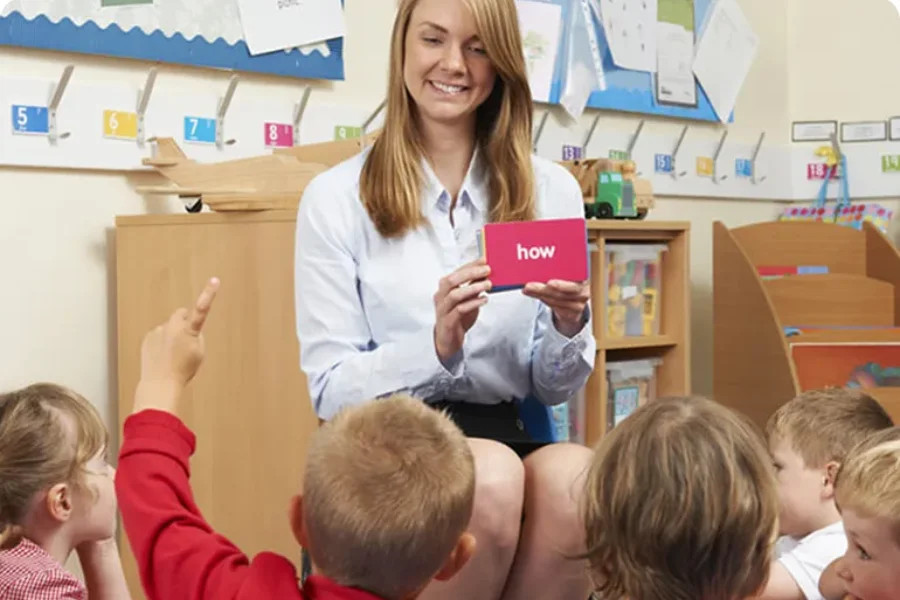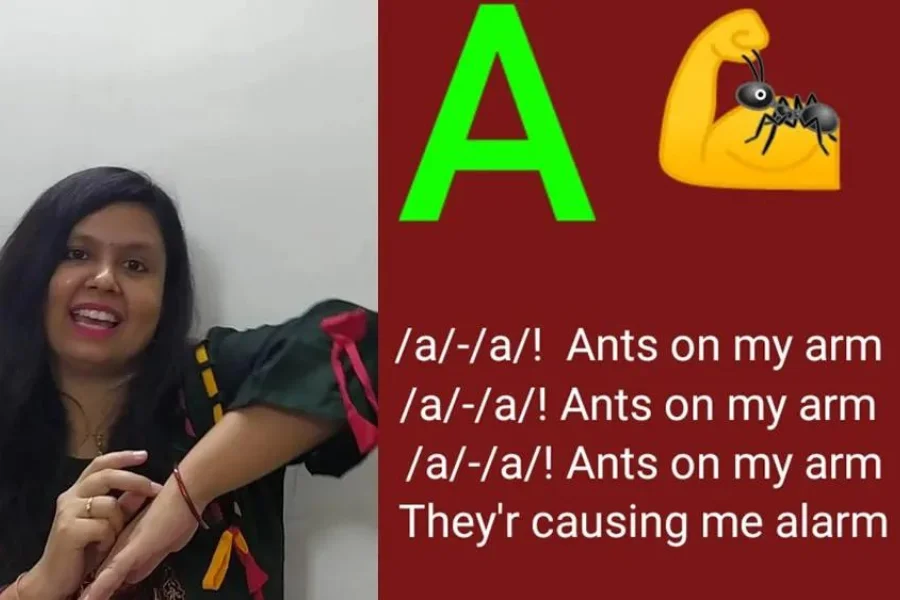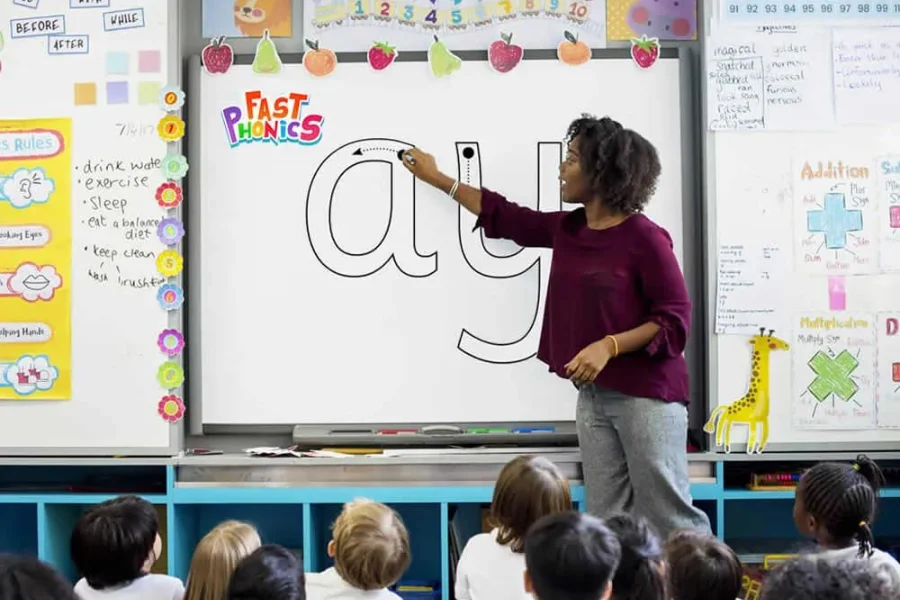
Source: istockphoto
Phonics for Kg helps young learners create a robust foundation in reading using sound-based practices. Phonics for Kg also boosts their phonemic understanding, facilitating them to listen and manipulate individual sounds in words. Proficiency in letter recognition and sound blending helps kindergarteners in early reading and academic success. Innovative activities make learning delightful and efficacious for little learners.
For more details of Phonics Teaching Course Call / Whatsapp +919869866277 / +919869546913
To Download Brochure of Phonics Teaching Course, Click Here!
What are Phonics Words for Kindergarten?
Phonics for Kg includes simple words that can be learned using the sounds of letters. Learning Phonics for Kg words helps children master fundamental reading and spelling skills, making it effortless for them to read without external guidance.
Here’s how Phonics Words for Kindergarten are introduced:
Letter Sounds:
Common consonant sounds
Start teaching children commonly used consonants like s, t, p, n, m, d.
Examples:
- s as in sun
- t as in top
- p as in pan
- n as in net
- m as in map
- d as in dog
Short vowel sounds
Introduce vowel sounds using simple examples such as:
- a as in apple
- e as in egg
- i as in igloo
- as in octopus
- u as in umbrella
Digraphs
Teach combinations of two letters making a single sound:
- ch as in chip
- sh as in ship
- th as in thin
Blending Sounds to Make Words:
CVC (Consonant-Vowel-Consonant) words
Begin with uncomplicated, easily readable words that children can quickly learn:
cat, dog, sun, pig, hat
Practice blending
Guide students to say each sound clearly, then blend them to read the entire word smoothly.
Visual aids
Use flashcards, images, and word-building games to boost word recognition.
Examples of Phonics for Kg Words:
- Short “a” words: cat, hat, sat, pan, tap
- Short “e” words: pen, ten, bed, met, red
- Short “i” words: pig, sit, big, win, pin
- Short “o” words: dog, pot, top, box, fox
- Short “u” words: fun, cup, run, gut, hug
Key Phonics for Kg Skills
Sound-letter association
Comprehending the association between letters and their distinct sounds.
Blending
Integrating individual sounds into words.
Segmenting
Breaking words down into separate sounds.
Decoding
Reading unknown words using phonics understanding.
Phonics for Kg gives children the means they need for confident reading and communication.

Source: maloointernationalschool
How do you Teach Phonics in Kg?
Teaching Phonics for Kg involves a systematic strategy to help children develop reading fluency by understanding the letter-sound association.
Teach Phonics in Kg by incorporating these steps:
Step 1 – Introducing Letter Sounds
- Children first comprehend letter recognition and their association with sounds.
- Writing practice is introduced alongside letter recognition to help children form letters correctly.
Step 2 – Reading Words
Children learn to read words using the sounds of letters. They start reading consonant-vowel-consonant words (CVC words).
As they advance, they move to more intricate words like:
- CCVC words (e.g., stop, plan)
- CVCC words (e.g., milk, past)
Step 3 – Learning Digraphs
- Then children move on to learning Digraphs (a two-letter combination that makes a single sound).
- Along with digraphs, children are also taught tricky words that fail to follow typical phonics rules, such as he, she, was, they, all, etc.
Step 4 – Understanding Alternative Graphemes
Children discover multiple ways of spelling the same sound.
For example:
- The ai sound can be written as ai (rain), ay (day), a_e (make), eigh (eight), or a (apron).
- The ea spelling appears in different words with different pronunciations, like sea, head, break, etc.
- Learning these variations helps children decode unfamiliar words more effectively.
Step 5 – Building Fluency and Accuracy
By this phase, children can identify and read many words automatically. They practice sounding out unknown words while improving spelling.
They begin learning spelling rules, including:
- Prefixes (e.g., unhappy, redo)
- Suffixes (e.g., playing, walked)
- Silent letters (e.g., knock, write)
Everyday reading exercises help grow reading speed, fluency, and comprehension.
Step 6 – Supporting Your Child’s Reading with Phonics
To strengthen phonics learning at home or in the classroom:
- Read audibly with children and boost sounding out words.
- Use innovative phonics games, flashcards, and jingles to make learning a joy.
- Encourage writing practice with simple words and sentences.
- Help children identify tricky and sight words that don’t obey phonetic practices.
Phonics for Kg lays a strong basis for reading success. With everyday practice and interesting activities, children gain confidence in identifying words, and comprehending sounds, thus evolving into independent readers.

Source: readingeggs
How to Practice Phonics at Home?
Practice Phonics at Home to help children amplify their reading and spelling skills. Begin with letter sound recognition by articulating a letter and having your child create the sound. Promote blending by slowly enunciating words and allowing them to put the sounds together. Read easy books with CVC words and use flashcards, letter quests, rhyming games, etc., to make learning fun.
Sing phonics jingles and recite nursery rhymes to reinforce sounds. Engage in writing activities using sand, chalk, or paper to help with letter formation. Constant practice through entertaining activities builds confidence and helps children evolve into fluent readers.
How do I Become a Certified Phonics Teacher?
Become a Certified Phonics Teacher and help young learners acquire vital reading skills. A certified Phonics Teaching Course provides structured training on Phonics for Kg principles, teaching approaches, classroom management strategies, etc.
Here’s how you can Become a Certified Phonics Teacher:
Choose a Phonics Certification Program
- Enroll in a recognized course that offers structured phonics training.
- Vidhyanidhi Education Society provides a well-designed Phonics Teaching Course.
- Look for courses that cover phonics rules, lesson planning, and assessment methods.
Complete the Training
- Learn letter-sound relationships, blending, segmenting, and word formation.
- Gain hands-on experience through practical teaching sessions.
- Understand how to teach phonics effectively to different age groups.
Get Certified
- After finishing coursework and assessments, obtain your Certified Phonics Teacher certificate.
- Certification enhances credibility and career possibilities in schools and learning centres.
Apply Your Skills
- Use Phonics for Kg strategies to teach reading in classrooms, private tutoring, or online programs.
- Continue learning and updating phonics teaching methods.
By becoming a Certified Phonics Teacher, you can support children in mastering Phonics for Kg and building a powerful foundation in reading while advancing your teaching career.
Join the Phonics Teaching Course from Vidhyanidhi Education Society today!
For more details of Phonics Teaching Course Call / Whatsapp +919869866277 / +919869546913
To Download Brochure of Phonics Teaching Course, Click Here!
FAQs
How long is the Phonics Course?
Phonics courses typically span over a few weeks to a few months, depending on the training provider. Vidhyanidhi Education Society offers flexible learning choices.
What is the Best Age to Learn Phonics?
The best age to start phonics is 3 to 6 years. However, phonics is advantageous in any year for reading and writing mastery.
Is Phonics Taught in Kindergarten?
Yes, phonics is an integral part of kindergarten education, assisting children learn letter sounds, blending, and interpreting words to build early reading mastery.



